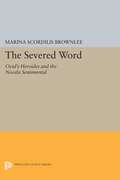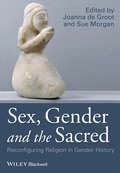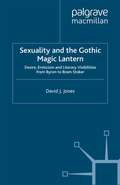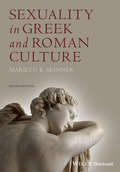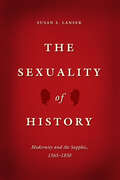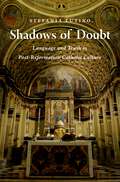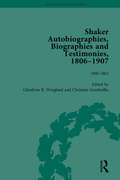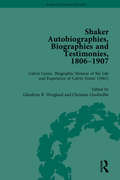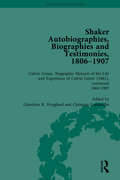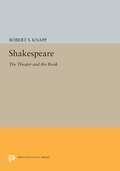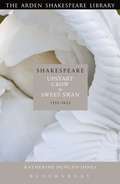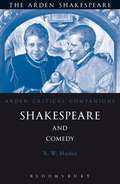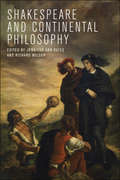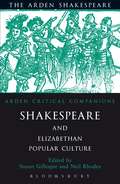- Table View
- List View
The Severed Word: Ovid's "Heroides" and the "Novela Sentimental"
by Marina Scordilis BrownleeIn this wide-ranging study Marina Scordilis Brownlee investigates the importance of the letter--often a complex interplay of objectivity and subjectivity--in the establishment of novelistic discourse. She shows how Ovid's Heroides explore the discourse of epistolarity in a way that exerted a lasting effect on Italian, French, and Spanish works of the Middle Ages and Renaissance, especially on the fifteenth-century Spanish novela sentimental, or "sentimental romance." Presenting this proto-novelistic form as a highly original rewriting of Ovid, Brownlee demonstrates that its language model interrogates rather than affirms the linguistic referentiality implied by romance. Whereas the ambiguity of the sign had been articulated in fourteenth-century Spain (most notably by the Libro de buen amor), it is the fifteenth-century novela sentimental that fully grasps the existentially, novelistically dire consequences of this ambiguity. And in the process of deconstructing the referentiality that underlies romance, the novela sentimental reveals itself to be a discursively essential step in the evolution of the modern novel.Originally published in 1990.The Princeton Legacy Library uses the latest print-on-demand technology to again make available previously out-of-print books from the distinguished backlist of Princeton University Press. These editions preserve the original texts of these important books while presenting them in durable paperback and hardcover editions. The goal of the Princeton Legacy Library is to vastly increase access to the rich scholarly heritage found in the thousands of books published by Princeton University Press since its founding in 1905.
Sex, Gender and the Sacred: Reconfiguring Religion in Gender History (Gender and History Special Issues)
by Joanna De Groot Sue MorganSex, Gender and the Sacred presents a multi-faith, multi-disciplinary collection of essays that explore the interlocking narratives of religion and gender encompassing 4,000 years of history. Contains readings relating to sex and religion that encompass 4,000 years of gender history Features new research in religion and gender across diverse cultures, periods, and religious traditions Presents multi-faith and multi-disciplinary perspectives with significant comparative potential Offers original theories and concepts relating to gender, religion, and sexuality Includes innovative interpretations of the connections between visual, verbal, and material aspects of particular religious traditions
Sex, Gender and the Sacred: Reconfiguring Religion in Gender History (Gender and History Special Issues)
by Joanna De Groot Sue MorganSex, Gender and the Sacred presents a multi-faith, multi-disciplinary collection of essays that explore the interlocking narratives of religion and gender encompassing 4,000 years of history. Contains readings relating to sex and religion that encompass 4,000 years of gender history Features new research in religion and gender across diverse cultures, periods, and religious traditions Presents multi-faith and multi-disciplinary perspectives with significant comparative potential Offers original theories and concepts relating to gender, religion, and sexuality Includes innovative interpretations of the connections between visual, verbal, and material aspects of particular religious traditions
Sexuality and the Gothic Magic Lantern: Desire, Eroticism and Literary Visibilities from Byron to Bram Stoker (Palgrave Gothic)
by D. JonesThis fascinating study explores the multifarious erotic themes associated with the magic lantern shows, which proved the dominant visual medium of the West for 350 years, and analyses how the shows influenced the portrayals of sexuality in major works of Gothic fiction.
Sexuality in Greek and Roman Culture (Ancient Cultures #3)
by Marilyn B. SkinnerThis agenda-setting text has been fully revised in its second edition, with coverage extended into the Christian era. It remains the most comprehensive and engaging introduction to the sexual cultures of ancient Greece and Rome. Covers a wide range of subjects, including Greek pederasty and the symposium, ancient prostitution, representations of women in Greece and Rome, and the public regulation of sexual behavior Expanded coverage extends to the advent of Christianity, includes added illustrations, and offers student-friendly pedagogical features Text boxes supply intriguing information about tangential topics Gives a thorough overview of current literature while encouraging further reading and discussion Conveys the complexity of ancient attitudes towards sexuality and gender and the modern debates they have engendered
Sexuality in Greek and Roman Culture (Ancient Cultures)
by Marilyn B. SkinnerThis agenda-setting text has been fully revised in its second edition, with coverage extended into the Christian era. It remains the most comprehensive and engaging introduction to the sexual cultures of ancient Greece and Rome. Covers a wide range of subjects, including Greek pederasty and the symposium, ancient prostitution, representations of women in Greece and Rome, and the public regulation of sexual behavior Expanded coverage extends to the advent of Christianity, includes added illustrations, and offers student-friendly pedagogical features Text boxes supply intriguing information about tangential topics Gives a thorough overview of current literature while encouraging further reading and discussion Conveys the complexity of ancient attitudes towards sexuality and gender and the modern debates they have engendered
The Sexuality of History: Modernity and the Sapphic, 1565-1830
by Susan S. LanserThe period of reform, revolution, and reaction that characterized seventeenth- and eighteenth-century Europe also witnessed an intensified interest in lesbians. In scientific treatises and orientalist travelogues, in French court gossip and Dutch court records, in passionate verse, in the rising novel, and in cross-dressed flirtations on the English and Spanish stage, poets, playwrights, philosophers, and physicians were placing sapphic relations before the public eye. In The Sexuality of History, Susan S. Lanser shows how intimacies between women became harbingers of the modern, bringing the sapphic into the mainstream of some of the most significant events in Western Europe. Ideas about female same-sex relations became a focal point for intellectual and cultural contests between authority and liberty, power and difference, desire and duty, mobility and change, order and governance. Lanser explores the ways in which a historically specific interest in lesbians intersected with, and stimulated, systemic concerns that would seem to have little to do with sexuality. Departing from the prevailing trend of queer reading whereby scholars ferret out hidden content in “closeted” texts, Lanser situates overtly erotic representations within wider spheres of interest. The Sexuality of History shows that just as we can understand sexuality by studying the past, so too can we understand the past by studying sexuality.
The Sexuality of History: Modernity and the Sapphic, 1565-1830
by Susan S. LanserThe period of reform, revolution, and reaction that characterized seventeenth- and eighteenth-century Europe also witnessed an intensified interest in lesbians. In scientific treatises and orientalist travelogues, in French court gossip and Dutch court records, in passionate verse, in the rising novel, and in cross-dressed flirtations on the English and Spanish stage, poets, playwrights, philosophers, and physicians were placing sapphic relations before the public eye. In The Sexuality of History, Susan S. Lanser shows how intimacies between women became harbingers of the modern, bringing the sapphic into the mainstream of some of the most significant events in Western Europe. Ideas about female same-sex relations became a focal point for intellectual and cultural contests between authority and liberty, power and difference, desire and duty, mobility and change, order and governance. Lanser explores the ways in which a historically specific interest in lesbians intersected with, and stimulated, systemic concerns that would seem to have little to do with sexuality. Departing from the prevailing trend of queer reading whereby scholars ferret out hidden content in “closeted” texts, Lanser situates overtly erotic representations within wider spheres of interest. The Sexuality of History shows that just as we can understand sexuality by studying the past, so too can we understand the past by studying sexuality.
The Sexuality of History: Modernity and the Sapphic, 1565-1830
by Susan S. LanserThe period of reform, revolution, and reaction that characterized seventeenth- and eighteenth-century Europe also witnessed an intensified interest in lesbians. In scientific treatises and orientalist travelogues, in French court gossip and Dutch court records, in passionate verse, in the rising novel, and in cross-dressed flirtations on the English and Spanish stage, poets, playwrights, philosophers, and physicians were placing sapphic relations before the public eye. In The Sexuality of History, Susan S. Lanser shows how intimacies between women became harbingers of the modern, bringing the sapphic into the mainstream of some of the most significant events in Western Europe. Ideas about female same-sex relations became a focal point for intellectual and cultural contests between authority and liberty, power and difference, desire and duty, mobility and change, order and governance. Lanser explores the ways in which a historically specific interest in lesbians intersected with, and stimulated, systemic concerns that would seem to have little to do with sexuality. Departing from the prevailing trend of queer reading whereby scholars ferret out hidden content in “closeted” texts, Lanser situates overtly erotic representations within wider spheres of interest. The Sexuality of History shows that just as we can understand sexuality by studying the past, so too can we understand the past by studying sexuality.
The Sexuality of History: Modernity and the Sapphic, 1565-1830
by Susan S. LanserThe period of reform, revolution, and reaction that characterized seventeenth- and eighteenth-century Europe also witnessed an intensified interest in lesbians. In scientific treatises and orientalist travelogues, in French court gossip and Dutch court records, in passionate verse, in the rising novel, and in cross-dressed flirtations on the English and Spanish stage, poets, playwrights, philosophers, and physicians were placing sapphic relations before the public eye. In The Sexuality of History, Susan S. Lanser shows how intimacies between women became harbingers of the modern, bringing the sapphic into the mainstream of some of the most significant events in Western Europe. Ideas about female same-sex relations became a focal point for intellectual and cultural contests between authority and liberty, power and difference, desire and duty, mobility and change, order and governance. Lanser explores the ways in which a historically specific interest in lesbians intersected with, and stimulated, systemic concerns that would seem to have little to do with sexuality. Departing from the prevailing trend of queer reading whereby scholars ferret out hidden content in “closeted” texts, Lanser situates overtly erotic representations within wider spheres of interest. The Sexuality of History shows that just as we can understand sexuality by studying the past, so too can we understand the past by studying sexuality.
The Sexuality of History: Modernity and the Sapphic, 1565-1830
by Susan S. LanserThe period of reform, revolution, and reaction that characterized seventeenth- and eighteenth-century Europe also witnessed an intensified interest in lesbians. In scientific treatises and orientalist travelogues, in French court gossip and Dutch court records, in passionate verse, in the rising novel, and in cross-dressed flirtations on the English and Spanish stage, poets, playwrights, philosophers, and physicians were placing sapphic relations before the public eye. In The Sexuality of History, Susan S. Lanser shows how intimacies between women became harbingers of the modern, bringing the sapphic into the mainstream of some of the most significant events in Western Europe. Ideas about female same-sex relations became a focal point for intellectual and cultural contests between authority and liberty, power and difference, desire and duty, mobility and change, order and governance. Lanser explores the ways in which a historically specific interest in lesbians intersected with, and stimulated, systemic concerns that would seem to have little to do with sexuality. Departing from the prevailing trend of queer reading whereby scholars ferret out hidden content in “closeted” texts, Lanser situates overtly erotic representations within wider spheres of interest. The Sexuality of History shows that just as we can understand sexuality by studying the past, so too can we understand the past by studying sexuality.
The Sexuality of History: Modernity and the Sapphic, 1565-1830
by Susan S. LanserThe period of reform, revolution, and reaction that characterized seventeenth- and eighteenth-century Europe also witnessed an intensified interest in lesbians. In scientific treatises and orientalist travelogues, in French court gossip and Dutch court records, in passionate verse, in the rising novel, and in cross-dressed flirtations on the English and Spanish stage, poets, playwrights, philosophers, and physicians were placing sapphic relations before the public eye. In The Sexuality of History, Susan S. Lanser shows how intimacies between women became harbingers of the modern, bringing the sapphic into the mainstream of some of the most significant events in Western Europe. Ideas about female same-sex relations became a focal point for intellectual and cultural contests between authority and liberty, power and difference, desire and duty, mobility and change, order and governance. Lanser explores the ways in which a historically specific interest in lesbians intersected with, and stimulated, systemic concerns that would seem to have little to do with sexuality. Departing from the prevailing trend of queer reading whereby scholars ferret out hidden content in “closeted” texts, Lanser situates overtly erotic representations within wider spheres of interest. The Sexuality of History shows that just as we can understand sexuality by studying the past, so too can we understand the past by studying sexuality.
Shaker Autobiographies, Biographies and Testimonies, 1806 - 1907 Vol 1
by GlendyneR WerglandIn the late eighteenth century a small Shaker community travelled to America under the leadership ofMother Ann Lee. The American communities they founded were based on ideals of pacifism, celibacy and gender equality. The texts included in this edition come from first-hand accounts of life in the Shaker communities during the nineteenth century.
Shaker Autobiographies, Biographies and Testimonies, 1806 - 1907 Vol 1 (American Communal Societies Ser.)
by GlendyneR WerglandIn the late eighteenth century a small Shaker community travelled to America under the leadership ofMother Ann Lee. The American communities they founded were based on ideals of pacifism, celibacy and gender equality. The texts included in this edition come from first-hand accounts of life in the Shaker communities during the nineteenth century.
Shaker Autobiographies, Biographies and Testimonies, 1806 - 1907 Vol 2
by GlendyneR WerglandIn the late eighteenth century a small Shaker community travelled to America under the leadership ofMother Ann Lee. The American communities they founded were based on ideals of pacifism, celibacy and gender equality. The texts included in this edition come from first-hand accounts of life in the Shaker communities during the nineteenth century.
Shaker Autobiographies, Biographies and Testimonies, 1806 - 1907 Vol 2 (American Communal Societies Ser.)
by GlendyneR WerglandIn the late eighteenth century a small Shaker community travelled to America under the leadership ofMother Ann Lee. The American communities they founded were based on ideals of pacifism, celibacy and gender equality. The texts included in this edition come from first-hand accounts of life in the Shaker communities during the nineteenth century.
Shaker Autobiographies, Biographies and Testimonies, 1806 - 1907 Vol 3
by GlendyneR WerglandIn the late eighteenth century a small Shaker community travelled to America under the leadership ofMother Ann Lee. The American communities they founded were based on ideals of pacifism, celibacy and gender equality. The texts included in this edition come from first-hand accounts of life in the Shaker communities during the nineteenth century.
Shaker Autobiographies, Biographies and Testimonies, 1806 - 1907 Vol 3 (American Communal Societies Ser.)
by GlendyneR WerglandIn the late eighteenth century a small Shaker community travelled to America under the leadership ofMother Ann Lee. The American communities they founded were based on ideals of pacifism, celibacy and gender equality. The texts included in this edition come from first-hand accounts of life in the Shaker communities during the nineteenth century.
Shakespeare: The Theater and the Book
by Robert S. KnappThis book explores the reasons for the lasting freshness and modernity of Shakespeare's plays, while revising the standard history of English medieval and Renaissance drama. Robert Knapp argues that changes in the authority of English monarchs, in the differentiation and integration of English society, in the realization of human figures on stage, and in the understanding of signs helped produce scripts that still compel us to the act of interpretation.Originally published in 1989.The Princeton Legacy Library uses the latest print-on-demand technology to again make available previously out-of-print books from the distinguished backlist of Princeton University Press. These editions preserve the original texts of these important books while presenting them in durable paperback and hardcover editions. The goal of the Princeton Legacy Library is to vastly increase access to the rich scholarly heritage found in the thousands of books published by Princeton University Press since its founding in 1905.
Shakespeare: 1592-1623
by Katherine Duncan-JonesAn original and provocative study of the evolution of Shakespeare's image, building on the success of Duncan-Jones' acclaimed biography of Shakespeare. Taking a broadly chronological approach, she investigates Shakespeare's changing reputation, as a man, an actor and a poet, both from his own viewpoint and from that of his contemporaries. Many different categories of material are explored, including printed books, manuscripts, literary and non-literary sources. There are biographical elements, but it is not a biography. The change in public opinion in Shakespeare's time is quite startling: Henry Chettle attacked him as an 'upstart Crow' in 1592, an attack from which Shakespeare sought to defend himself; and yet by the time of the First Folio in 1623 he had become the 'Sweet Swan of Avon!' and was fast becoming the national treasure he remains today.This engaging and fascinating study brings the politics and fashions of Shakespeare's literary and theatrical world vividly to life
Shakespeare: 1592-1623 (Arden Shakespeare Library)
by Katherine Duncan-JonesAn original and provocative study of the evolution of Shakespeare's image, building on the success of Duncan-Jones' acclaimed biography of Shakespeare. Taking a broadly chronological approach, she investigates Shakespeare's changing reputation, as a man, an actor and a poet, both from his own viewpoint and from that of his contemporaries. Many different categories of material are explored, including printed books, manuscripts, literary and non-literary sources. There are biographical elements, but it is not a biography. The change in public opinion in Shakespeare's time is quite startling: Henry Chettle attacked him as an 'upstart Crow' in 1592, an attack from which Shakespeare sought to defend himself; and yet by the time of the First Folio in 1623 he had become the 'Sweet Swan of Avon!' and was fast becoming the national treasure he remains today.This engaging and fascinating study brings the politics and fashions of Shakespeare's literary and theatrical world vividly to life
Shakespeare And Comedy (Arden Critical Companions)
by Robert MaslenComedy was at the centre of a critical storm that raged throughout the early modern period. Shakespeare's plays made capital of this controversy. In them he deliberately invokes the case against comedy made by the Elizabethan theatre haters. They are filled with jokes that go too far, laughter that hurts its victims, wordplay that turns to swordplay and aggressive acts of comic revenge. Through a detailed study which considers tragedies and histories as well as comedies, Maslen contends that Shakespeare's use of the comic mode is always calculatedly unsettling, and that this is part of what makes it pleasurable.
Shakespeare and Continental Philosophy
by Jennifer Bates Richard WilsonThis collection of 15 essays by celebrated authors in Shakespeare studies and in continental philosophy develops different aspects of the interface between continental thinking and Shakespeare's plays. The authors draw from current continental philosophy (e.g. Lacan, Foucault, Derrida) as well as from the 19th century continental tradition (e.g. Hegel, Kierkegaard) and from the early roots of continental tradition (e.g. Aristotle, Ibn Sina). The chapters address the span of the tragedies, comedies and history plays in the light of thinkers as diverse as Aristotle, Ibn Sina and Jean-Luc Marion, Hegel, Kierkegaard, Schopenhauer, Schmitt, Arendt, Lacan, Levinas, Foucault and Derrida.
Shakespeare And Elizabethan Popular Culture: Arden Critical Companion (Arden Critical Companions)
by Neil Rhodes Stuart GillespieWhile much has been written on Shakespeare's debt to the classical tradition, less has been said about his roots in the popular culture of his own time. This is the first book to explore the full range of his debts to Elizabethan popular culture. Topics covered include the mystery plays, festive custom, clowns, romance and popular fiction, folklore and superstition, everyday sayings, and popular songs. These essays show how Shakespeare, throughout his dramatic work, used popular culture. A final chapter, which considers ballads with Shakespearean connections in the seventeenth century, shows how popular culture immediately after his time used Shakespeare.
